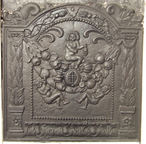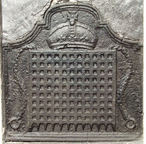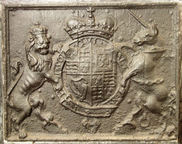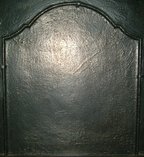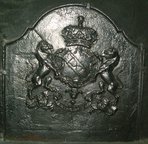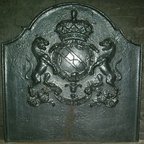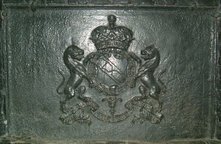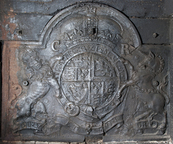-
591
Description: Arched rectangular shaped; cavetto-moulded edging; on each side a column of large overlapping leaves above a pedestal with a single rose; issuing from the top of each column two ribbons, in figure-of-eight with grenade terminals, fly across the arch; within an arched central panel with bead edging three naked children disport about a swag of fruit, with a central pomegranate, suspended from the top of each column; one figure sits on the top, facing right, the other two hang symmetrically from below; along the base is a line of acanthus leaves; on top a sea serpent is curled on each end.
Notes: The design may have been inspired by the paintings of Jan Pauwel Gillemans the younger (1651-1704); he may have worked in London in 1675-8. Another version (no. 575), probably by the same pattern maker, has a central finial on top and different proportioned fruit and figures. Copies of this fireback were advertised in Bratt Colbran Ltd.'s (London) catalogue in the early-20th century.
Copies of this fireback are known.
- Decoration tags:
- 'Dutch' (shape)
- cavetto (edging)
- whole carved pattern
- pictorial
- mythological
- humans
- plants
Manufactured: in the mid- to late-17th century in England.
Current location: Ham House, Richmond, Surrey, England.
Museum number: 1140116 (part of the National Trust museum group)
- Attached to series:
- Carolean 'Dutch' series
-
592
Description: Flattened arched rectangular shape with rebated concave shoulders; double fillet edging; 11 x 9 grid portcullis with symmetrical chains in ‘S’ arrangement ending in a ring, from top corners, surmounted by an arched royal crown.
Notes: Whole pattern; the portcullis has a realistic, rather than symbolic, appearance.
Copies of this fireback are known.
- Decoration tags:
- rectangular with canted top corners and round arch (shape)
- stepped fillet (edging)
- whole carved pattern
- heraldic
- pictorial
- objects
Manufactured: in the late-16th to early-17th century in England.
Current location: Ham House, Richmond, Surrey, England.
Museum number: 1140112 (part of the National Trust museum group)
- Attached to series:
- Miscellaneous royal firebacks
-
593
Description: Rectangular, cavetto moulded edging; Stuart royal shield, garter, supporters and crown.
Notes: Four clear vertical plank lines indicate that the pattern for this fireback was formed of a series of boards probably secured by horizontal battens on the rear.
Copies of this fireback are known.
Inscription: HONI SOIT QVI MAL Y PENSE
Arms: English Stuart royal
- Decoration tags:
- rectangular (shape)
- cavetto (edging)
- whole carved pattern
- planklines
- armorial
- royal
- text
Manufactured: in the late-17th century in England.
Current location: Ham House, Richmond, Surrey, England.
Museum number: 1140118 (part of the National Trust museum group)
- Attached to series:
- Stuart royal armorial firebacks
-
890
Description: Canted rectangle; cavetto moulded edging (top and sides); single horizontal fillet below canted corners and vertical fillet parallel to each side, dividing the fireback into two side panels, two top corner panels, top panel and main central panel; corner panels, ‘daisy’ plant stamp; top panel, date between ‘daisy’ stamps, between initials in triad at each end; side panels, swirling foliage stamp repeated each side above a fleur-de-lys, above initial 'I' on left and 'B' on right; centre panel, stamp of ‘Indian’ smoking a pipe at top left, stamp of seated ‘gentleman’ smoking a pipe and holding another, at top right; below each, a seated monkey stamp, that on the left seated facing right, its paws in front of it and its tail below, that on the right seated facing left, its tail drawn across its chest.
Notes: The IB initials are identical to those on similar firebacks dated between 1703 and 1721, probably indicating the same founder. The number 3 of the date and the fleur-de-lys on the lower left side have been over-pressed showing the backs of the stamps. The use of stamps relating to tobacco smoking may suggest an origin near Bristol, the main entry port for the tobacco trade at that time.
Inscription: IES [triad] 1703 IES [triad] / I B
- Decoration tags:
- rectangular with canted top corners (shape)
- fillet (edging)
- carved stamps
- heraldic
- text
- animals
- humans
- plants
- objects
Manufactured: in 1703 in the Forest of Dean area of England.
Current location: Greys Court, Rotherfield Greys, Oxfordshire, England.
Museum number: 196857 (part of the National Trust museum group)
- Attached to series:
- IB series
- Fleur-de-lys firebacks
-
685
Description: Rectangular with arched rectangular shaped top joined by cavetto curves; astragal edging; plain surface for the addition of other stamps or panels.
Notes: Used for armorials by the Dukes of Dorset.
- Decoration tags:
- rectangular with canted top corners and round arch (shape)
- astragal (edging)
- whole carved pattern
Manufactured: in the early-18th century in the Weald area of England.
Current location: Knole, Sevenoaks, Kent, England.
Museum number: 129673 (part of the National Trust museum group)
- Attached to series:
- Dorset arms series
- Base boards
-
686
Description: Rectangular with arched rectangular shaped top joined by cavetto curves; astragal edging; shield, supporters, ducal coronet, motto and garter of the Duke of Dorset: Quarterly, Or and gules, a bend vair.
Notes: Almost certainly the arms of Lionel Sackville KG (1688-1765), created first duke of Dorset in 1720.
Inscription: [around shield] HONY SOIT QUI MAL Y PENSE / [on motto scroll] AUT NUNQUAM TENTES, AUT PERFICE
Arms: Lionel Sackville, 1st Duke of Dorset
- Decoration tags:
- rectangular with canted top corners and round arch (shape)
- astragal (edging)
- carved pattern panels
- armorial
- text
Manufactured: in the early-18th century in the Weald area of England.
Current location: Knole, Sevenoaks, Kent, England.
Museum number: 129683 (part of the National Trust museum group)
- Attached to series:
- Dorset arms series
- Sackville firebacks
- Personal armorial firebacks
-
687
Description: Rectangular with arched rectangular shaped top joined by cavetto curves; astragal edging; shield, supporters, ducal coronet, motto and garter of the Duke of Dorset: Quarterly, Or and gules, a bend vair.
Notes: Almost certainly the arms of Lionel Sackville KG (1688-1765), created first duke of Dorset in 1720.
Copies of this fireback are known.
Inscription: [around shield] HONY SOIT QUI MAL Y PENSE / [on motto scroll] AUT NUNQUAM TENTES, AUT PERFICE
Arms: Lionel Sackville, 1st Duke of Dorset
- Decoration tags:
- rectangular with canted top corners and round arch (shape)
- astragal (edging)
- carved pattern panels
- armorial
- text
Manufactured: in the early-18th century in the Weald area of England.
Current location: Knole, Sevenoaks, Kent, England.
Museum number: NT/KNO/M/41 (part of the National Trust museum group)
- Attached to series:
- Dorset arms series
- Sackville firebacks
- Personal armorial firebacks
-
688
Description: Rectangular; astragal edging; in centre, shield, supporters, ducal coronet, motto and garter of the Duke of Dorset: Quarterly, Or and gules, a bend vair.
Notes: Almost certainly the arms of Lionel Sackville KG (1688-1765), created first duke of Dorset in 1720.
Inscription: [around shield] HONY SOIT QUI MAL Y PENSE / [on motto scroll] AUT NUNQUAM TENTES, AUT PERFICE
Arms: Lionel Sackville, 1st Duke of Dorset
- Decoration tags:
- rectangular (shape)
- astragal (edging)
- carved pattern panels
- armorial
- text
Manufactured: in the early-18th century in the Weald area of England.
Current location: Knole, Sevenoaks, Kent, England.
(part of the National Trust museum group)
- Attached to series:
- Dorset arms series
- Sackville firebacks
- Personal armorial firebacks
-
350
Description: Arched rectangular shape; cavetto edging; armorial; Stuart English royal arms within a circular garter; crown, motto and supporters (crowned lion and unicorn); initials separated by crown.
Notes: An early casting of a widely copied fireback. A later copy with an inserted, probably spurious, date is no. 1303. Inferior copies of this fireback were advertised in Kings Worthy Foundry's (Winchester) catalogue in the mid-20th century.
Copies of this fireback are known.
Inscription: C R / HONI SOIT QVI MAL Y PENSE / DIEU ET MON DROIT
Arms: English Stuart royal
- Decoration tags:
- rectangular with round arch (shape)
- cavetto (edging)
- whole carved pattern
- armorial
- royal
- text
Manufactured: in the mid-17th century in England.
Current location: Knole, Sevenoaks, Kent, England.
(part of the National Trust museum group)
- Attached to series:
- Carolean royal armorial firebacks
- Stuart royal armorial firebacks
-
1094
Description: Rectangular; twisted rope edging (top and sides); top centre, crowned Tudor royal shield between a lion passant on the right and a lion passant guardant sinister on the left; in each top corner a crowned four-petal rose, below which, to the right, a left-facing 'imp' with both arms lowered; below the armorial, a crowned shield bearing initials, KH, in Lombardic lettering, above a fleur-de-lys; a much-corroded imp figure may be below the right-hand lion.
Notes: A heavily corroded variant of a type bearing Henrician heraldic elements.
Arms: Tudor royal arms of England
- Decoration tags:
- rectangular (shape)
- rope (edging)
- carved stamps
- heraldic
- armorial
- animals
- humans
Manufactured: in the mid-16th century in the Weald area of England.
Current location: Smallhythe Place, Small Hythe Road, Tenterden, Kent, England.
Museum number: 1117950 (part of the National Trust museum group)
- Attached to series:
- Royal series
